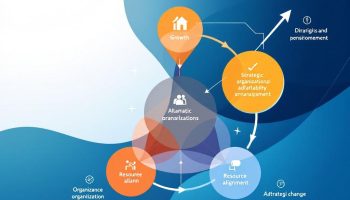
Operational Effectiveness Strategy: 9 Proven Approaches for Business Optimization
Process automation, lean management, data-driven decision making, cross-functional team optimization, technology infrastructure enhancement, employee development, quality management systems, supply chain optimization, and customer experience enhancement are nine proven operational effectiveness strategies that can transform your business performance. These approaches provide a comprehensive framework to streamline operations, cut costs, and boost productivity across all business functions.
Why Businesses Need Operational Effectiveness Strategies
Implementing operational effectiveness strategies like process automation and data-driven decision making is now essential for maintaining competitive advantage in today’s fast-paced business environment. Companies that successfully deploy these nine strategies typically see significant improvements in efficiency metrics, often reporting 15-30% gains in productivity and notable cost reductions. These approaches help you eliminate wasteful processes, optimize resource allocation, and create lasting improvements that directly impact your bottom line. Additionally, as markets grow more competitive, these operational effectiveness strategies enable your organization to respond quickly to changing customer demands while maintaining quality standards and driving innovation.
9 Effective Operational Effectiveness Strategy Examples: Unlock Business Success Today
In the pursuit of operational excellence, organizations can adopt a variety of strategies to enhance efficiency and productivity. In this section, we’ll explore nine powerful operational effectiveness strategy examples that can drive significant improvements across your business. From implementing process automation to optimizing supply chains, each of these strategies showcases practical applications that lead to better performance and competitive advantage. Whether you’re aiming to reduce costs, improve customer satisfaction, or streamline workflows, these examples provide insightful, actionable approaches for organizations of all sizes. Let’s delve into each example and discover how they can transform your operational landscape.
“`html
1. Process Automation Implementation
Implementing process automation is a fundamental operational effectiveness strategy example that can transform business efficiency. You can identify repetitive tasks like data entry, report generation, and approval workflows that consume valuable time. By deploying RPA (Robotic Process Automation) solutions, you eliminate human error while increasing processing speed by up to 70%.
Automated workflow management systems create seamless operations across departments, especially when integrated with existing platforms. The results are particularly impressive in finance departments, where operational effectiveness improvements through automation can reduce processing times by 85%.
Key automation implementation areas include:
- Invoice processing and payment systems
- Customer onboarding procedures
- Inventory management
- Compliance reporting
- Employee timesheet processing
Companies that successfully automate routine processes typically redirect their workforce toward higher-value activities, leading to both cost savings and revenue growth. Consider conducting a post-implementation audit to measure the actual benefits achieved through your automation initiatives.
“`
2. Lean Management Principles for Operational Effectiveness Strategy
Implementing lean management principles represents a powerful operational effectiveness strategy example that can transform your business performance. By focusing on eliminating waste and maximizing value, you can achieve remarkable efficiency improvements across your organization. Value stream mapping allows you to visualize all steps in your delivery process, identifying bottlenecks and opportunities for optimization.
The elimination of non-value-adding activities is central to lean methodology. This involves analyzing every business process to determine which steps truly add value to customers and which can be modified or eliminated. When you implement continuous improvement initiatives, you systematically reduce waste in terms of time, resources, and effort.
Just-in-time inventory management reduces carrying costs and minimizes waste by ensuring materials arrive precisely when needed for production. This approach requires tight coordination with suppliers and accurate demand forecasting.
The Toyota Production System serves as the quintessential example of lean principles in action. Toyota’s implementation demonstrates how operational effectiveness strategies can create sustainable competitive advantage through:
- Reduced lead times
- Lower inventory costs
- Improved product quality
- Enhanced customer satisfaction
- Greater production flexibility
Expert Insight: To enhance operational effectiveness through lean management, focus on value stream mapping to identify and eliminate wasteful processes. Implement just-in-time inventory to optimize resource use and reduce costs while fostering continuous improvement initiatives. This approach can lead to improved quality, customer satisfaction, and a sustainable competitive advantage.
3. Data-Driven Decision Making
Implementing operational effectiveness strategy examples starts with leveraging data to drive business decisions. By tracking real-time performance metrics, you can identify bottlenecks and improvement opportunities across your organization. Deploying predictive analytics tools allows you to anticipate market shifts and customer behaviors, giving your business a competitive edge.
Creating comprehensive KPI dashboards provides a visual representation of your operational effectiveness metrics, making complex data accessible to all stakeholders. These dashboards should include both leading and lagging indicators to provide a complete picture of performance.
Consider these key components for your data-driven approach:
- Real-time performance tracking systems that monitor operational KPIs
- Predictive analytics tools that forecast future trends
- Customized dashboards that present data in actionable formats
- Regular data review sessions with cross-functional teams
A prime example of successful implementation is predictive analytics for sales forecasting using historical data analysis. This approach enables sales teams to allocate resources more effectively, prioritize high-potential opportunities, and adjust strategies based on data-backed insights rather than intuition alone.
Expert Insight: Leverage data-driven decision-making by implementing real-time performance tracking and predictive analytics tools. Create comprehensive KPI dashboards to visually represent key metrics, ensuring accessibility for all stakeholders. Regular data review sessions foster collaboration and enable informed strategic adjustments, enhancing operational effectiveness and maintaining a competitive edge.
4. Cross-Functional Team Optimization for Operational Effectiveness
Implementing cross-functional team structures is a powerful operational effectiveness strategy example that breaks down departmental silos. When you reorganize teams to include members from various disciplines, you create units capable of addressing complex business challenges more efficiently.
Clear role definition and accountability are crucial components of this strategy. By explicitly outlining each team member’s responsibilities, you eliminate confusion and prevent task duplication. This clarity directly enhances your operational effectiveness by ensuring everyone understands their contribution to overall objectives.
Establishing standardized communication protocols further strengthens team performance. These protocols should include:
- Regular stand-up meetings to address immediate concerns
- Digital collaboration platforms for real-time information sharing
- Documented decision-making processes
- Escalation pathways for critical issues
Agile project management teams exemplify successful cross-functional optimization. These teams combine individuals from development, quality assurance, business analysis, and product management to deliver products iteratively. By implementing effective project collaboration techniques, they minimize handoffs between departments and accelerate delivery timelines. Companies that adopt this approach typically report 20-30% improvements in project completion rates and significant reductions in operational costs.
Expert Insight: To optimize cross-functional teams for operational effectiveness, ensure clear role definitions and establish standardized communication protocols. Regular stand-up meetings and digital collaboration platforms enhance coordination, while agile project management fosters efficient collaboration. This approach can lead to 20-30% improvements in project completion rates and reduced operational costs.
5. Technology Infrastructure Enhancement for Operational Effectiveness
Implementing the right technology infrastructure is a cornerstone of an operational effectiveness strategy that you can apply to transform your business performance. Cloud computing adoption provides scalability and cost efficiency while reducing physical infrastructure maintenance costs. Moving your critical systems to cloud platforms enables your team to access information from anywhere, improving collaboration and response times.
Legacy system modernization addresses outdated technology that often creates bottlenecks in your operational workflow. By upgrading these systems, you eliminate inefficiencies that hamper productivity. Creating a comprehensive digital transformation roadmap helps prioritize technology investments that deliver the highest operational impact.
For example, migrating to cloud-based ERP systems can streamline your business processes across departments. This integration eliminates data silos and provides real-time visibility into operations, enabling faster decision-making. Many organizations report a 15-25% improvement in operational efficiency after implementing cloud-based solutions.
Consider these infrastructure enhancement approaches:
- Implementing API integrations between systems
- Adopting containerization for application deployment
- Establishing robust cybersecurity protocols
- Creating database analytics frameworks that support operational decisions
Expert Insight: Enhancing your technology infrastructure is crucial for operational effectiveness. Embrace cloud solutions for scalability and efficiency, and modernize legacy systems to eliminate workflow bottlenecks. Prioritize strategic investments in API integrations and cybersecurity to foster seamless collaboration and improve decision-making across your organization.
6. Employee Development Programs for Operational Effectiveness Strategy
Implementing robust employee development programs is a cornerstone of any operational effectiveness strategy. These programs directly impact your organization’s ability to execute efficiently and adapt to changing market conditions. By investing in your workforce, you create a foundation for operational excellence that drives sustainable results.
Begin with a comprehensive skill gap analysis to identify areas where your team needs improvement. This assessment helps pinpoint specific operational effectiveness strategy examples that will yield the greatest impact. Map current capabilities against future business needs to create targeted development plans.
Design training initiatives that specifically address operational efficiency skills:
- Process improvement methodologies
- Technology proficiency relevant to your industry
- Problem-solving and critical thinking
- Change management capabilities
- Data analysis and interpretation
Establish performance monitoring systems to track how employee development impacts operational metrics. This continuous improvement approach ensures your training investments deliver measurable returns. Regular assessment allows you to refine your development strategy over time.
Technical certification programs represent an excellent example of targeted development. These structured learning paths ensure your team gains standardized skills that directly contribute to operational effectiveness in business contexts. Consider industry-specific certifications that align with your strategic objectives.
7. Quality Management Systems
Implementing robust quality management systems is a cornerstone of operational effectiveness strategy examples that organizations can leverage to enhance performance. You can establish ISO certification implementation as a foundation for standardized processes that align with global best practices. Quality control processes should be embedded throughout your operations to identify and address defects before they reach customers.
Continuous improvement protocols like continuous improvement cycles enable your teams to consistently refine procedures and eliminate inefficiencies. A powerful example of quality management implementation is Six Sigma methodology adoption, which has helped companies like Motorola and GE reduce defects to 3.4 per million opportunities.
To maximize your quality management system’s impact:
- Implement regular quality audits to ensure compliance
- Train employees on quality control techniques and principles
- Establish clear metrics to measure quality performance
- Create feedback loops to capture improvement opportunities
Quality management significantly contributes to operational effectiveness by reducing waste, enhancing customer satisfaction, and improving project integration management across departments. When properly implemented, these systems can transform organizational culture to prioritize excellence at every level.
8. Supply Chain Optimization for Operational Effectiveness
Implementing a robust supply chain optimization strategy is crucial to achieving operational effectiveness in today’s competitive business environment. By focusing on strategic vendor relationship management, you can create partnerships that deliver cost savings while maintaining quality standards. Many organizations have improved their operational effectiveness strategy by developing scorecards to evaluate supplier performance regularly.
Logistics efficiency improvement represents another vital component of supply chain optimization. You can reduce transportation costs and delivery times by analyzing shipping routes and consolidating shipments. Implementing supply optimization techniques allows your business to minimize waste while maximizing value throughout the distribution network.
Inventory optimization directly impacts your operational effectiveness strategy by balancing stock levels against demand fluctuations. Consider these proven approaches:
- Implementing ABC analysis to prioritize inventory management efforts
- Utilizing economic order quantity (EOQ) models to determine optimal order sizes
- Deploying just-in-time (JIT) inventory systems to reduce holding costs
Advanced warehouse management systems exemplify operational effectiveness strategy in action. These technologies integrate barcode scanning, RFID tracking, and automated picking systems to enhance accuracy and throughput while reducing labor costs.
9. Customer Experience Enhancement for Operational Effectiveness Strategy
Implementing a comprehensive customer experience enhancement is a key operational effectiveness strategy example that directly impacts your bottom line. By standardizing service delivery processes, you create consistency across all customer touchpoints, reducing errors and improving satisfaction rates. This standardization forms the foundation of operational efficiency while maintaining quality interactions.
Developing systematic feedback collection mechanisms allows you to gather actionable insights about your customer journey. You can implement:
- Post-interaction surveys using NPS (Net Promoter Score)
- Social media sentiment analysis tools
- Customer focus groups for qualitative feedback
- Automated feedback requests at key touchpoints
Response time optimization is another crucial component that significantly affects customer perception. By analyzing current response patterns and implementing operational effectiveness improvements, you can reduce wait times and resolve issues more efficiently.
CRM system implementation exemplifies this strategy in action. Modern CRM platforms integrate customer data across departments, enabling personalized interactions while streamlining internal processes. This technology investment helps track customer history, predict needs, and support continuous improvement in service delivery, making it an essential tool for organizations seeking to enhance both customer satisfaction and operational performance.
Operational Effectiveness Strategies for Transforming Business Performance
Process automation, lean management, data-driven decision making, cross-functional team optimization, technology infrastructure enhancement, employee development programs, quality management systems, supply chain optimization, and customer experience enhancement represent the nine proven operational effectiveness strategies that can transform business performance. These strategic approaches work together to streamline operations, reduce waste, improve decision-making, and ultimately create sustainable competitive advantages for organizations seeking to optimize their performance.
Importance of Operational Effectiveness Strategies
Operational effectiveness strategies like process automation, lean management, and data-driven decision making are essential for businesses facing increased market competition and rapidly evolving customer expectations. These nine approaches help organizations:
- Reduce operational costs
- Improve product and service quality
- Accelerate time-to-market
- Enhance employee productivity
- Create more resilient business operations that can quickly adapt to changing market conditions
By implementing these strategies, organizations can not only optimize their performance but also ensure long-term sustainability in a competitive landscape.






